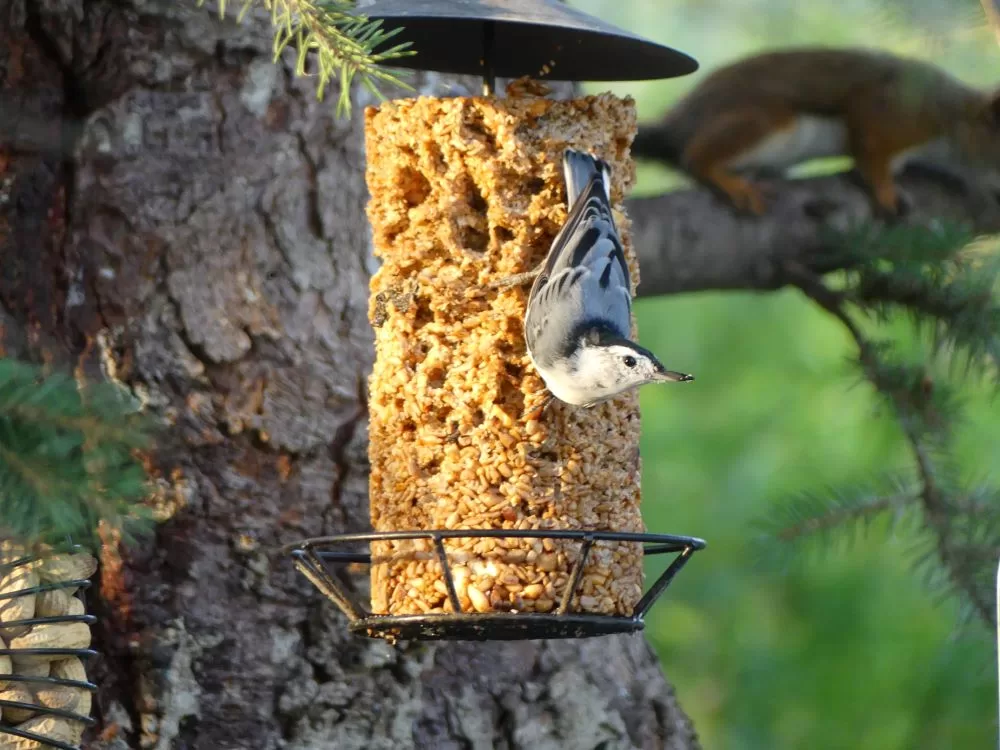Species Overview
The White-breasted Nuthatch, scientifically known as Sitta carolinensis, is a small but distinctive bird found across North America. This section covers the identification and description of the species, as well as its distribution and habitat preferences.
Identification and Description
The White-breasted Nuthatch is easily identifiable by its contrasting plumage. It has a white face, black crown, and a blue-gray back. The breast is white, while the underparts are a soft gray. Adults typically measure about 6.3 to 7.4 inches in length, and their wingspan ranges from 9.8 to 11.8 inches.
The species features a stout, pointed bill adapted for foraging. Its long tail and compact body enable agile movements among tree branches. The nuthatch is known for its habit of climbing down trees headfirst, a unique behavior among North American woodpeckers. A distinctive characteristic is its sharp, loud call, which aids in communication within mixed flocks.
Distribution and Habitat
The White-breasted Nuthatch primarily inhabits deciduous and mixed forests, as well as parks and large trees. Its range extends across eastern North America, from southern Canada to the United States, and into the Cascade Range of British Columbia.
These birds prefer areas with abundant mature trees and often forage among the bark for insects and seeds. They are known to thrive in both urban and rural settings, adapting well to various habitats. The population is stable, but habitat loss poses potential risks to their conservation status.
Behavior and Ecology
The White-breasted Nuthatch exhibits distinct behaviors and ecological roles that are essential for its survival and reproduction. Their feeding habits are diverse, while their unique nesting practices reflect adaptations to their environment.
Feeding Habits
This species is primarily an insectivore, foraging for a variety of insects, including ants and spiders. In addition to insects, it consumes seeds and nuts, with a preference for sunflower seeds, acorns, and peanuts. They are known for their ability to extract food from bark crevices and tree trunks, which they do by wedging food items into these spaces for easy access later.
White-breasted Nuthatches have also adapted to utilize feeders. They often visit bird feeders to access suet and corn, showcasing their opportunistic feeding behavior. Their foraging strategy involves climbing headfirst down tree trunks, allowing them to find abundance in their arboreal habitat.
Reproduction and Life Cycle
During the breeding season, female White-breasted Nuthatches select nest sites, often utilizing tree cavities or artificial nest boxes. A typical clutch consists of 4 to 8 eggs, which the female incubates for about 12 to 14 days. After hatching, the young are altricial, meaning they are dependent on their parents for food and care.
Both parents participate in feeding the chicks, which fledge approximately 2 to 3 weeks after hatching. This species may raise two broods in a single breeding season, increasing their reproductive success. Vocalizations play a role during courtship and throughout the nesting period, where songs and calls facilitate communication between mating pairs.
Conservation and Study
Conservation efforts and scientific research on the White-breasted Nuthatch play a vital role in understanding and protecting this species. Engaging the public and fostering a sense of stewardship are essential components of these initiatives.
Research and Monitoring
Organizations like the Cornell Lab of Ornithology conduct ongoing research to monitor the White-breasted Nuthatch population trends. Through studies on their life history and nesting behaviors, scientists gather valuable data that informs conservation actions.
Key research efforts include:
- Population surveys: Regular monitoring of nuthatch populations helps track changes in distribution and abundance.
- Habitat studies: Understanding habitat preferences is essential for effective conservation strategies.
- Vocalization analysis: This research aids in identifying subspecies and their respective ranges.
Partners in Flight collaborates with various organizations to provide essential insights into the species’ status, which guides management decisions.
Public Engagement and Education
Public engagement initiatives are crucial for fostering awareness about the White-breasted Nuthatch’s conservation status. Educational programs often highlight the bird’s importance in local ecosystems and its unique characteristics.
Elements of successful engagement include:
- Photo galleries: Visual tools that showcase nuthatches encourage interest and appreciation.
- Workshops and presentations: These educational activities inform community members about local bird species and conservation efforts.
- Citizen science projects: Involving the public in monitoring efforts fosters a sense of responsibility toward protecting wildlife.
Through these strategies, conservation organizations successfully mobilize efforts to support this species and promote its preservation.
Share this content:

Post Comment
You must be logged in to post a comment.